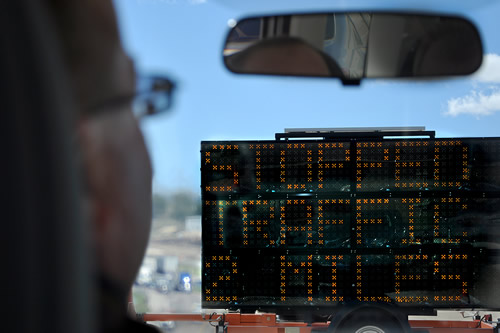End-of-queue warning systems alert drivers about slowing or stopped vehicles ahead

What’s the Problem?
For decades, transportation agencies across the country have sought ways to reduce rear-end crashes in and around construction zones. TTI researchers are supporting the Texas Department of Transportation’s (TxDOT’s) $2.1 billion I-35 Expansion Project with a first-of-its-kind traveler information system. The construction project covers 96 miles of I-35 across four Central Texas counties and often requires implementing active work zones during heavy travel times. Depending on the capacity of the stretch of road, traffic slowdown and stoppages can occur during lane closures. This is dangerous for both inattentive drivers and construction work crews, especially at night.
What’s the Solution?
While industry solutions for end-of-queue warning systems existed previously, TTI led the deployment of these systems for use in work zones on a nightly basis. The Institute worked with TxDOT to develop the specification for the I-35 application as well as the impacts analysis that lead to deployment recommendations. The main purpose of these systems is to let motorists know about a queue of stopped or slowed vehicles as they approach it, improving safety by decreasing the likelihood of rear-rend crashes. The system uses portable changeable messages signs (PCMSs) to alert drivers about slowing or stopped vehicles ahead. Better-informed motorists make for safer driving, and that can protect workers in the work zone as well as contribute to the corridor’s overall mobility.
How Does the System Work?
Radar detection devices are mounted ahead of work-zone lane closures to monitor and measure the speeds of approaching vehicles. Data from multiple sensors are analyzed and, as vehicles slow down, an algorithm triggers a message for display on PCMSs located a few miles upstream of the construction site. As a result, motorists are warned well in advance of the slow-down as it happens. For example, when traffic slows or stops, the messages on the PCMSs might read “Slow Traffic – 3 miles,” or “Stopped Traffic Ahead.” When no queue is detected by the system, the PCMS displays a more generic “Road Work Ahead” message. “These systems are portable and easy to set up on a nightly basis,” Research Scientist Bob Brydia says. Brydia is TTI’s principal investigator on the traveler information project. “Research indicates that they provide effective communication to drivers.”
Benefits
The end-of-queue warning system is part of a larger construction traveler information solution developed by TTI for TxDOT that also includes Bluetooth® technology to help monitor traffic flow. After the I-35 Expansion Project is completed in 2015, TxDOT’s Waco District will keep this new intelligent transportation system infrastructure to help manage mobility, reduce congestion, and improve safety along I-35 in the district. “This system will let motorists know how far in advance there is a slow down,” TxDOT Director of Transportation Operations Larry Colclasure says. “It’s part of the overall effort to provide real-time information designed for motorists’ safety and the safety of the construction workers, too.”
Project Title
Facilitating Deployment Decisions of Highly Portable End-of-Queue Warning SystemsProject Sponsor(s)
Texas Department of Transportation
Project Category
Mobility
Project Termination Date
Project is ongoing
Project Publications
For More Information
Robert E. Brydia
Senior Research ScientistSystem Reliability Division
Texas A&M Transportation Institute
The Texas A&M University System
3135 TAMU
College Station, TX 77843-3135
Ph. (979) 317-2824
r-brydia@tamu.edu